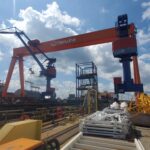
Australian sailors and shipbuilders have to participate in American operations and construction to learn how to build and operate their own nuclear-powered submarines as part of the AUKUS agreement, a key lawmaker said Tuesday. Speaking during a Center for Strategic and International Studies event on July 26, Rep. Rob Wittman (R-Va.), ranking member of the House Armed Services subcommittee on seapower and projection forces, said he and subcommittee chairman Rep. Joe Courtney (D-Conn.) have talked with Adm. James Caldwell, director…

 By
By 











